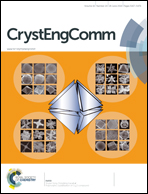Development of a transverse thermoelectric voltage effect in artificial SrTiO3/SrTi1−xNbxO3 epitaxial multilayer films with incline-oriented sublayers†
Abstract
Artificial SrTiO3/SrTi1−xNbxO3 multilayer films were epitaxially grown on 10° off-cut (001)-oriented LaAlO3 single crystal substrates by pulsed laser deposition. Microstructural characterization by X-ray diffraction and high resolution transmission electron microscopy indicated that the multilayer films were periodic modulated structures with atomically sharp interfaces and an inclined c-axis. All sublayers with inclined (001) planes were exactly tilted away from the interfaces by 10°. Unique transverse thermoelectric voltage signals were achieved up to 0.744 V in the multilayer films, which is hundreds times higher than that of bulk Nb-doped SrTiO3 (~3 mV) single crystals with the same inclined orientation. The response time of the signals, depending on the thermal relaxation process in this multilayer structure, increased exponentially from 600 ns to 1700 ns with increasing thickness of the SrTi1−xNbxO3 sublayer. Furthermore, the peak value of voltage presented a significant linear relationship with the energy absorbed by the film. The results demonstrated that the transverse thermoelectric voltage effect was improved in these films due to their multilayer structure with an inclined crystal orientation, which would expand the possibilities of thermoelectric devices for versatile applications.


 Please wait while we load your content...
Please wait while we load your content...